Abstract
Asphalt recycling technology with a high content of reclaimed asphalt pavement (RAP) is becoming more important as the price of paving materials rises and sustainable development and environmental conservation rules become more rigorous. Nevertheless, road authorities in numerous countries still prohibit the utilisation of RAP in asphalt mixes due to the negative impacts of RAP on the performance of asphalt mixtures. Consequently, different rejuvenators have been introduced to reinstate the original attributes of aged asphalt to resolve this issue. This study incorporated vacuum residue (VR) into mixtures with 40% RAP. The physical, rheological, and mechanical traits of the resultant samples were assessed. The results show that the 7.5% VR rejuvenator minimised the RAP asphalt ageing impact. Furthermore, the rejuvenating agent demonstrated physical and rheological rehabilitative benefits for the aged asphalt. The mechanical attributes of the rejuvenated samples were also enhanced compared to the virgin asphalt (VA) specimens.
1. Introduction
Infrastructures, especially highways, are crucial to national economic development []. As a country emerging from war, construction and development projects are abundant in Iraq. The sudden rise in infrastructure construction results in natural resources, such as aggregates and asphalt binders, being at risk of depleting. Consequently, the recycling waste materials trend is expanding. The pavement industry is a major source of emissions of carbon dioxide (CO2) []. For example, hot-mix asphalt (HMA) manufacturing was estimated to require 99 KWh (356 MJ) energy and produce 23.8 kg of CO2 per tonne []. On account of this, pavement recycling is essential for sustainable pavement building, particularly with heightened concerns for environmental protection and sustainable development [,,]. Studies have reported that replacing a portion of virgin components with RAP produced through grinding end-of-life (EoL) pavements is conceivable []. Nonetheless, reclaimed asphalt pavement (RAP) contains aged asphalt that differs from virgin asphalt (VA) in terms of physical and rheological qualities and distinctive composition []. The loss of features leads to significant and early discomfort, such as cracking, spalling, and ravelling, which reduces driving safety and increases maintenance expenses []. Furthermore, asphalt binder ageing is a disadvantage of RAP binders. Asphalt binder ageing could be separated into oxidative and thermoreversible. Thermoreversible ageing has also been termed physical, steric, and thixotropic hardening [].
A potential approach to preventing the negative impacts of RAP employment is incorporating rejuvenating agents [,,]. Rejuvenator-added binders containing RAP demonstrated reduced stiffness and resistance to rutting and improved resistance to thermal cracking [,]. Most rejuvenating agents are oil-based organic substances primarily composed of components such as high-penetration asphalt, low-viscosity oil, and rich aromatic compounds. Depending on the application procedure, rejuvenators could partly to entirely return the oxidised asphalt binder characteristics to their original viscoelastic condition [,]. The restorative effects could be achieved by regenerating volatiles and oils, during which adhesion attributes of the binders are preserved. This technique also allows the feasibility of reverting the asphaltene-to-maltene ratios of aged binders to their original condition [,]. Chemically, rejuvenating agents are similar to the maltene fraction in asphalt binders. The substances also could soften aged asphalt binders. Moreover, rejuvenating agents have been reported to enhance binder cracking resistance regardless of the type []. Although the utilisation of professional rejuvenation chemicals could lead to softer RAP, it is economically disadvantageous due to its high cost compared to employing new asphalt and aggregate during road construction []. Consequently, it is essential to develop cost-effective and ecologically friendly high-performance rejuvenating agents to increase RAP levels in reclaimed asphalt mixtures and guarantee their functionality [].
The influences of rejuvenators and crude oil on aged asphalt have been the subject of several scientific investigations, given their identical chemical structure [,]. Waste engine oil (WEO), heavy fuel oils, aromatic extract, tall oil, and maltene are examples of rejuvenating agents []. Yin et al. [] investigated the effectiveness of aromatic extracts and tall oil. Their report recorded diminished asphalt rigidity and restored original qualities following the incorporation of the substances. Nonetheless, the effectiveness of the rejuvenators declined with time. Wang et al. [] observed that employing WEO as a rejuvenator in incrementing aromatic contents increased the ductility of the aged asphalt samples assessed. The study reported that the optimal WEO concentration was influenced by sample characteristics (e.g., stiffness), and excess WEO resulted in a smooth pavement with degraded performance. Furthermore, the anti-stripping ingredient improved the WEO–asphalt adhesion; however, it failed at high temperatures. In another study, Li et al. [] assessed the influences of varying WEO addition amounts on aged asphalt properties. Standard performance evaluations demonstrated that the waste oil’s regeneration effect was obvious. The regeneration process was identified using microscopic and chemical structure analysis. Their report also suggested that incorporating a proper WEO amount might enhance the traditional physical characteristics of the asphalt. Moreover, standard asphalt performance at varying ages was restored primarily due to the inclusion of WEO, which supplemented the light elements in the aged asphalt. The study also documented that adding waste oil did not result in further chemical interactions. Nonetheless, excess WEO might lead to unwanted asphalt viscosity reduction; hence, the 1–4% dose was advised. The physical, rheological, and chemical aspects were assessed when the integration of WEO and maltene to revitalise the characteristics of recycled asphalt was examined in an investigation []. The attributes of the reclaimed asphalt were essentially found to be comparable to VA with the addition of the appropriate amounts of a hybrid rejuvenating agent. Nevertheless, the agent decreased the chemical ageing index (CAI) and asphalt content of the regenerated asphaltene. The thermogravimetric analysis (TGA) results also demonstrated that the rejuvenated specimens were more temperature-sensitive than the recycled asphalt.
In most cases, the ability of a rejuvenating agent to both enhance the characteristics of aged asphalt and reverse the effects of aging can determine the suitability of the agent. Vacuum residue (VR), often called vacuum tower distillation bottom (VTB), has received very little attention from researchers as a rejuvenating agent. The name VR denotes the products that remain after a vacuum distillation method. Based on the refining method and crude oil, the residue might range from very hard to very soft asphalt []. The VR composition varies greatly and has an essential effect on the mechanical properties and microstructure of asphalt binders []. The VR from oil-rich country refineries has been reported to record penetration up to 300 dmm and a 600 mm2/s viscosity at 135 °C. Nevertheless, the substance is considered a waste by-product [] and is limited for paving utilisation alone []. VR could be employed as a rejuvenating agent, considering its potential restorative capabilities for aged asphalt. In light of the aforementioned principles, the present study aims to incorporate VR as a rejuvenating agent into an asphalt mixture with 40% RAP. Physical and rheological evaluations were executed to determine the optimal concentration of VR to rejuvenate aged asphalt. The current study also used analytical techniques to establish mechanical performance assessment data, followed by a simple economic analysis.
2. The Objectives of the Study
This study aimed to determine the efficiency of using VR to improve the attributes of asphalt and asphalt mixtures containing 40% RAP. To attain this goal, mixes were created by combining different amounts of aged asphalt (40%) and virgin asphalt (60%) with various percentages of VR. It was established that the penetration, softening point, and ductility were the best metrics to determine the optimal dosage of the rejuvenating agent. Then, viscosity measurements, the storage stability, stiffness modulus, complex modulus, and phase angle were investigated. Next, tests such as the Marshal test, indirect tensile strength (ITS), moisture damage, and Cantabro loss measures were used to determine the mechanical performance of rejuvenated HMA mixes containing 40% aged binder. Finally, a cost comparison study was carried out to assess the price difference between asphalt mixes including VR and those that did not contain VR.
3. Experimental Design
3.1. Materials
The experimental plan used in this study involved the utilization of one type of asphalt binder with a penetration grade of 40–50 (which is primarily employed in Iraq). It was supplied by the Al-Qayyarah refinery (about 365 km north of Baghdad, the capital). The RAP material was collected from damaged pavement in Mosul city, Iraq, where the road was constructed using the asphalt binder of penetration grade 40–50. Meanwhile, VR was brought from the Al-Qayyarah refinery. It had a penetration of 160 dmm and 1.01 a specific gravity. The RAP material was cleaned to eliminate any dust particles and strange substances. Next, using a centrifuge extraction procedure and trichloroethylene as the solvent, the aged asphalt was removed from RAP, as stated by ASTM D2172 []. The RAP binder was then recovered by distilling the methylene chloride to separate it. The typical parameters of virgin and RAP asphalts are presented in Table 1. The aggregates used in this study were procured from the Al-Khazir district in Ninawa, Iraq. Aggregate attributes are the primary concern in designing asphalt mixes due to their impacts on the performance of the resultant mixtures.

Table 1.
The findings of standardized testing on the binders utilized.
3.2. Sample Preparation and Experimental Testing Plan
The present study prepared 2.5, 5.0, 7.5, and 10% VR rejuvenating agents, which were added separately into 40% aged asphalt and 60% VA binders to procure VR-rejuvenated samples. The rejuvenating agent was incorporated while heating the asphalt binders. A lab mixer set to 145 °C and 1500 rpm was utilised to homogenise the specimens for 30 min. The ideal rejuvenating agent content was determined via penetration, softening point, ductility, and viscosity evaluations. The current study included seven binders (see Table 2).

Table 2.
Kinds of asphalt binders with their codes.
4. Binder Test and Analysis Methods
The physical properties of asphalt binders and the optimal rejuvenating agent content were determined by conducting the following asphalt binder tests on both the aged asphalt and all of the rejuvenated asphalt specimens: penetration at 25 °C (ASTM D5), softening point (ASTM D36), and ductility (ASTM D113). In this part of the experiment, three repetitions for each type of asphalt binder were carried out, and the mean values of these values were computed. During this time, a dynamic viscosity test was carried out using a Brookfield Rotational Viscometer to characterize the rheology of the asphalt binders using ASTM D4402. The test was carried out over a temperature range of 135 to 165 °C at a shear rate of 20 rpm. In the meantime, ASTM D4124 was used to identify the fractions of maltene and asphaltene.
In contrast, the feasibility of rejuvenation of the aged asphalt using VR was investigated based on the stiffness modulus parameters via the nomographs for asphalt features established by Van der Poel []. The present study measured the stiffness of three different types of asphalt binders—virgin, aged, and rejuvenated—at minimal and elevated temperatures with various loading scenarios based on the results of penetration, softening point, and penetration index (PI). The elevated temperature is the median of the hottest seven-day period in Mosul, Iraq, of the previous five years, while the low temperature represents the average of the minimum one-day air temperature. Moreover, the complex modulus and phase angle of the specimens were calculated depending on the mean of the warmest seven-day period in Mosul, Iraq, of the previous five years using BitProps V2 software.
Following this, mixture tests were carried out to gauge the impact of VR on the HMA mixtures’ mechanical characteristics and moisture damage. The process of producing the asphalt mixtures involved the following steps. Initially, RAP and virgin aggregate were heated at 125 °C and 163 °C for 2 h. Then, the optimal amount of VR was combined with RAP for 1 min. Afterward, the RAP rejuvenated by VR was mixed with virgin aggregates before adding virgin asphalt to the mixture. Four different mixtures, virgin, 100% RAP, 40% RAP, and rejuvenated asphalt mixtures, were prepared. Twelve Marshall samples were prepared to assess stability, flow, and stiffness as per ASTM D6927. In addition, additional specimens were constructed with 7% ± 0.5% air voids for ITS testing to determine how susceptible the asphalt mixtures are to moisture. Both dry and wet tests were conducted on two different sets of samples. Furthermore, the Cantabro test was conducted (using the UCL method []) to assess the resistance of the mixtures to abrasion loss. Finally, a straightforward economic analysis was conducted to determine the economic advantages of employing RAP. The experimental program employed in this work is summarized in Figure 1.
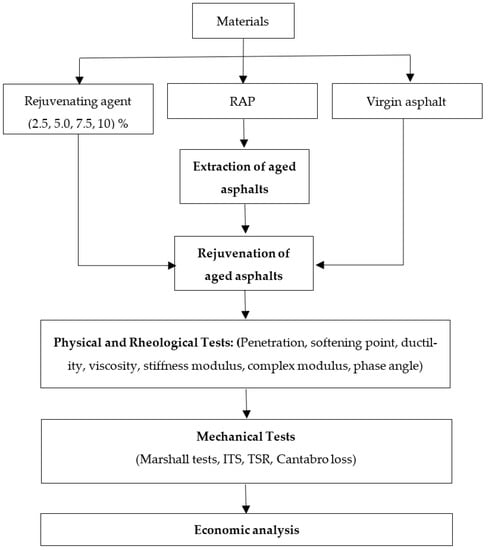
Figure 1.
Flowchart of the study.
5. Discussion of Results and Analysis
5.1. Ideal Rejuvenator Content Establishment
Penetration, softening point, and ductility assessments were performed on the aged asphalt binders with the addition of 2.5–10% (wt.% of asphalt binder) VR at a 2.5% increase to determine the optimum VR content and its effects on the physical properties of the asphalt. Penetration reflected the hardness degree of the specimens. On the other hand, the softening point denoted the viscosity and ductility of the asphalts, which corresponded to tensile deformation and flexibility []. In this study, the aged asphalts, AA and A40, demonstrated reduced penetration depth and ductility and an increased softening point (see Figure 2, Figure 3 and Figure 4). The observations were due to the light chemical components in the ageing asphalts changing into heavy chemicals, leading to enhanced thick, ring-like formations, such as asphaltene []. The 40–50 penetration grade VA is also included in the results for reference, demonstrating typical asphalt binder consistency data. Adding the VR to the aged asphalts led to improved penetration and ductility, and diminished softening point of the resultant mixtures. The trend continued with increasing VR content. The penetration values of the A40 (40 dmm) incorporated with 2.5, 5, 7.5, and 10% VR were 34, 38, 43 and 46 dmm, respectively. In contrast, the VA recorded 44 dmm. The softening points of the A40 considerably decreased from 55 to 53.5, 53, 51.5, and 48 °C when 2.5, 5, 7.5, and 10% VR were added, respectively. The results verified that VR could alleviate the stiffness from ageing. The enhanced penetration and decreased softening point were ascribable to the drop in the asphaltene-to-maltene ratio from maltene incorporation (see Table 3). The asphaltene and maltene percentages in the present study were based on the definition outlined in ASTM 4124 []. The asphaltene-to-maltene ratio in the A40 sample diminished to a value slightly higher than the VA after adding VR. Nevertheless, fully recovering the original properties of aged asphalt is challenging since the structural changes were brought on throughout its service life [].
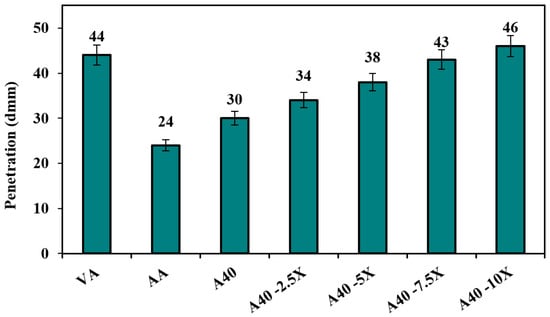
Figure 2.
The penetration values of the selected specimens.
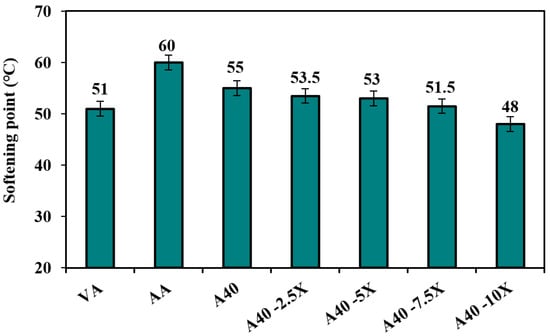
Figure 3.
The softening point values of the selected specimens.
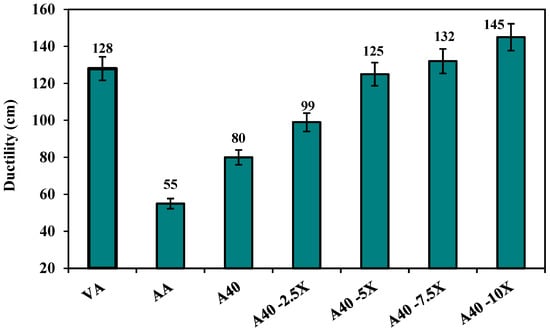
Figure 4.
The ductility values of the selected specimens.

Table 3.
Maltene and asphaltene ratios.
Based on Figure 4, the ductility values of the aged asphalts (AA and A40) were 55 and 80 cm, while the VA recorded 128 cm. The observations might be due to deteriorated asphalt characteristics following exposure to various conditions throughout its life, including high temperatures, pressure, humidity, dry air, heavy rain, and strong sunlight []. These influences result in oxidation and dehydrogenation, thus deteriorating the binder attributes. Subsequently, the asphaltene content in the binders rises and its oil and resin contents decrease, which, in turn, increases the brittleness of the asphalt and negatively affects the behaviours of the asphalt, especially at low temperatures.
The rejuvenated asphalts in the present study recorded 99, 125, 132, and 145 cm ductility at 2.5, 5, 7.5, and 10% VR addition, respectively. The improved ductility was attributable to decreasing asphaltene content. The VR compensated the oils and resins lost due to the previously mentioned conditions, rejuvenating the A40 blend. Based on Figure 2, Figure 3 and Figure 4, 7.5% VR was the optimal content required to restore the original characteristics of the aged asphalt in terms of penetration, softening point, and ductility. The rejuvenated and VA samples exhibited similarity in all attributes. Determining the ideal VR concentration is critical as excess rejuvenator could lead to binder stripping, which negatively impacts the rheological features and decreases the performance of the asphalt mixture [,].
5.2. Viscosity
In the current study, the aged asphalts, AA and A40, showed high viscosity values, 2600 and 1600 mPa·s at 135 °C and 840 and 400 mPa·s at 165 °C, respectively (see Table 4). Interior structural alterations in the asphalt binder were caused by the asphaltene/maltene percentages throughout short- and long-term aging, increasing the viscosity and hardening of the aged binder. Commonly, the short-term ageing of asphalts is due to construction operations, including mixing, transporting, and laying asphaltic materials []. Moreover, high temperatures further facilitate ageing []. Short-term aging is also affected by the oxidation and volatilization of the binders and oil components. On the other hand, oxidation, surface layer polymerisation, and photo-oxidation are the primary factors influencing long-term asphalt ageing []. Kinematic viscosity is directly correlated to the mixing and compaction temperature required. The ideal mixing viscosity range to achieve proper aggregate coating is approximately 200–500 mPa·s, while 170–250 mPa·s is the recommended range for maintaining acceptable paving workability []. In this study, the incorporation of 7.5% VR significantly enhanced the viscosity of the aged asphalt (A40) to 475 and 188 mPa·s at 135 and 165 °C. The results were similar to the data documented for the VA binder, 450 and 187 mPa·s at 135 and 165 °C. The present study also determined the penetration viscosity number (PVN) of several asphalt binders by utilising the penetration and viscosity values obtained at 25 and 135 °C to investigate the impacts of VR on the characteristics of the aged asphalt binders. A high PVN corresponds to low thermal sensitivity. Table 4 summarises the final PVN results obtained in this study. The aged asphalts recorded higher PVN than VA, suggesting more significant cracking capabilities. Nonetheless, the 7.5% VR-incorporated aged asphalt sample showed a considerably reduced PVN value to closer to the figure recorded for the VA. As a result, pavement deterioration caused by cracking decreased. The findings from the penetration, ductility, softening point, and viscosity assessments procured in this study suggested that incorporating 7.5% VR was suitable to produce the 40/50 grade asphalt mixture.

Table 4.
Viscosity and PVN values for the different asphalt binder types.
5.3. Stiffness Modulus of Asphalt Binder
Based on Table 5, the ageing process increased the rigidity of the VA, while adding the VR rejuvenator softened the aged asphalt. The 7.5% VR-rejuvenated asphalt recorded a comparable resistance against shear deformation to the VA binder. The VR mitigated the ageing impacts in aged asphalt by minimising the stiffness comparable to that of the VA. The changes observed in the present study indicated that penetration improved with rising maltene amounts, while the softening point was gradually reduced and nearly restored to a similar level to the VA. The addition of maltene led to reduced asphaltene levels in the binders. The stiffness values of the A40 samples were 0.0118, 0.1045, and 0.0222 MPa at 1.0, 0.1, and 0.55 s loading times, respectively, and elevated temperatures. Nonetheless, incorporating the VR diminished the values to 0.0062, 0.0569, and 0.0107 MPa, which were almost identical to the VA’s 0.0058, 0.0526, and 0.0097 MPa. At low temperatures, a comparable trend was documented. The A40-7.5X binder recorded stiffness values of 232.6, 524.8, and 297.9 MPa at 1.0, 0.1, and 0.55 s, respectively. Meanwhile, the VA binder registered 237, 536.2, and 309.8 MPa at 1.0, 0.1, and 0.55 s, respectively. The results showed that the values of the VA and restored asphalt binders were almost identical, signifying enhanced features of the aged asphalt post-rejuvenation.

Table 5.
Stiffness modulus of asphalt binders.
5.4. Complex Modulus and Phase Angle of Asphalt Binder
The complex modulus and phase angles of the virgin, aged, and rejuvenated asphalts in this study at 0.1, 1, and 10 Hz are illustrated in Figure 5 and Figure 6. The complex modulus reflects the resistance of the asphalts against deformation under shear force, where a higher value correlates to a better shear–deformation performance []. The phase angle denotes the viscous response of asphalts to shear deformation []. Asphalt binders with low phase angles typically exhibit more elasticity and better recovery from shear deformation. The differences between the aged and rejuvenated asphalts assessed in this study were significant within the entire frequency spectrum. The aged asphalt showed higher complex modulus values than the virgin and rejuvenated binders, indicating that the ageing development resulted in the asphalt binder becoming stiff to a great degree. Conversely, the values documented for the binder samples were relatively close, attributable to improved flexibility after rejuvenation.
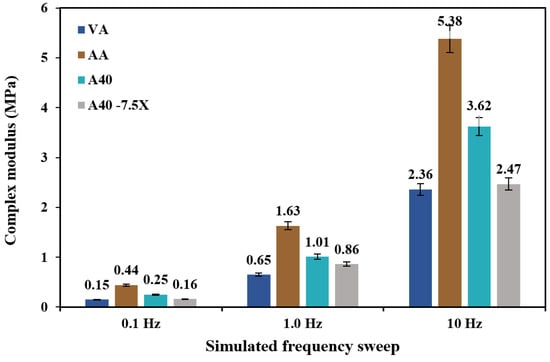
Figure 5.
Complex modulus for the asphalt binder samples.
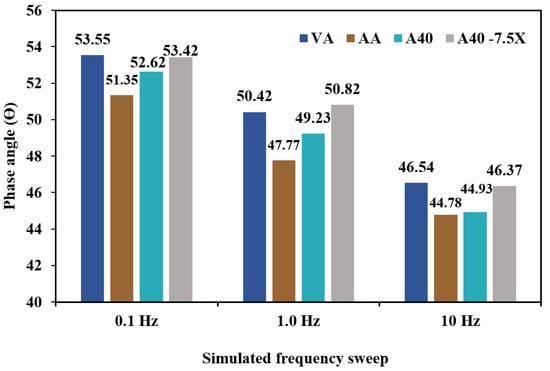
Figure 6.
Phase angle for the asphalt binder samples.
The phase angle of the VA was significantly reduced post-ageing. Higher phase angle values correspond to more viscous substances in the asphalt binder. In this study, the viscoelastic properties of the aged asphalt varied considerably from the VA binder. The observations were ascribable to the aged asphalt binder containing fewer viscous materials than the VA binder, which was a result of the oxidation and evaporation of several light chemicals. The 7.5% VR-rejuvenated asphalt binders evaluated in the current study showed a substantially reduced complex modulus, and phase angle values were increased. The VR-rejuvenated samples also showed improved viscosity, which was lower than the aged asphalt binder, and viscoelastic characteristics close to the original amount. These findings were consistent with the rotational viscosity data. The complex modulus and phase angle data confirmed the physical measurements, where the VR rejuvenator could soften the aged asphalt for all frequencies. Nonetheless, the rejuvenated asphalt binder showed a lower phase angle and higher complex modulus at higher frequencies, while at lower frequencies, it recorded a higher phase angle and lowered complex modulus. A comparison between the aged and rejuvenated binder samples indicated that the rejuvenating agent could affect the mechanical response of the rejuvenated materials. The complex modulus figures of the rejuvenated asphalts were also slightly higher; however, the phase angle values were less than the VA. These findings implied that VR could alter aged asphalt. Moreover, VR-restored asphalts had better resistance against rutting at high temperatures than VA binders.
5.5. Marshall Properties
The Marshall properties evaluation results of the HMA samples in this study are summarised in Table 6. The values procured exhibited a typical trend in the presence of the RAP and rejuvenating agent. The RAP positively impacted stability, which improved loading capacity and rutting resistance. The AA and A40 recorded 19 and 17.39 kN stability values, respectively, while 14.1 kN was documented for the VA. The better Marshall stability demonstrated by the RAP-containing samples was attributed to the effects of the RAP binder stiffening []. Nevertheless, the mixtures were more brittle and susceptible to deterioration at intermediate and minimal temperatures with increasing stiffness. Moreover, the stiffening effects of the RAP reduced the asphalt mixture flow when its brittleness rose. The AA and A40 samples recorded 2.3 mm and 2.61 mm flow values compared to 3.1 mm of the VA mixture.

Table 6.
Marshall test results.
Consequently, VR was utilised to regain performance or output lost due to stiffened binders. The VR inclusion decreased the stability of the samples to 15.19 kN and enhanced the flow value to 3.4 mm, hence diminishing the stiffness to values comparable to that of the VA mixtures. These observations implied that the VR-added samples were more flexible than the RAP mixtures. The incorporation of VR increased the maltene components (saturates, aromatics, and resins) in the asphalt binder and reduced the asphaltene content. Similar trends were also reported in a study by Al-Saffar et al. []. The relationship between the Marshall quotient (MQ) (Marshall stability divided by flow) and mixture type is listed in Table 6. The RAP samples (AA and A40) exhibited higher MQ values (8.26 and 6.66 kN/mm). Consequently, the mixtures had higher resistance to shear stress, permanent deformation, and rutting. Conversely, adding VR decreased the MQ to close to that of the VA, where A4-7.5X recorded 4.47 kN/mm and 4.54 kN/mm was documented for the VA.
5.6. Moisture Damage
The ITS test is commonly employed to assess the vulnerability of asphalt mixtures to moisture. Higher ITS and TSR values generally imply that the mixtures would exhibit good performance and resistance to moisture impairment []. The conditioned and unconditioned ITS figures obtained in this study are demonstrated in Figure 7. The TSR figures, which are criteria for moisture susceptibility, are also illustrated on the secondary vertical axes in Figure 7. The ITS values of the RAP-containing mixtures were higher than the virgin and rejuvenated samples. The findings suggested that the ITS values were dominated by the RAP proportion, which appeared to be stronger and stiffer than the virgin HMA. Nevertheless, adding VR diminished the ITS values, which was a result of increased flexibility. The ITS values of the RAP mixtures at 60 °C (conditioned samples) were also lower than at 25 °C (unconditioned). The observations were as expected and attributed to cohesion loss in the mixtures. The A40 samples had the maximum TSR values, while the AA specimens (100% RAP) had the lowest figures. The findings were attributable to the loss of adhesion and cohesion properties of the R100 during its lifespan. Meanwhile, the A40-7.5X exhibited a slightly different TSR value compared to A40. The mixtures containing 40% RAP had better resistance against moisture impairment than the virgin and rejuvenated samples. The solid bonds between the aggregate and RAP binder were higher than that of the VA, which resulted in reducing the susceptibility of the asphalt mixtures to moisture damage. Furthermore, the results indicated that the VR had no negative impact on the moisture damage resistance of the mixtures, considering that the TSR value of A40-7.5X was 83.9%, while A40 demonstrated 84.3%.
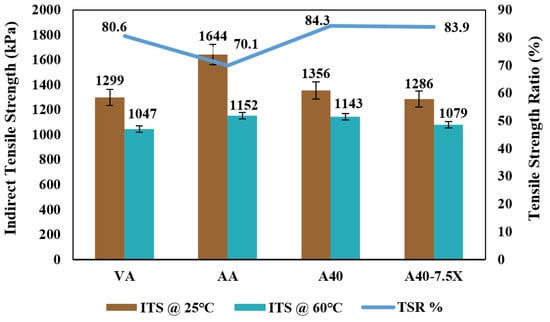
Figure 7.
ITS and TSR for the different types of asphalt mixtures.
5.7. Cantabro Loss
Durability is critical to RAP-containing asphalt mixtures to avoid premature impairment. This property could be evaluated through the immersed-Cantabro assessment []. Figure 8 demonstrates the mass loss documented for the asphalt samples assessed at 25 and 60 °C. The incorporation of RAP into the HMA raised the mass loss, where the VA specimen recorded a 6.87% mass loss at 25 °C and 9.07% at 60 °C. The values increased to 9.75 and 12.25% with the addition of 40% RAP, while the AA specimen (100% RAP) recorded 13.44 and 17.65% at 25 and 60 °C.
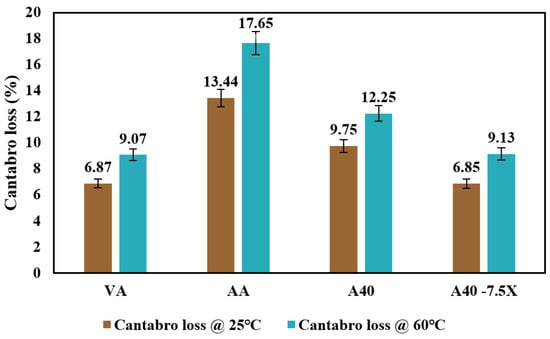
Figure 8.
Cantabro loss for the different asphalt binder types.
Mass loss is raised with ageing and different weather conditions. Consequently, a mixture might become more susceptible to durability concerns with time than VA mixtures [,]. Nevertheless, the addition of VR increased the durability of the samples. The specimens recovered their original RAP-containing asphalt mixture traits and exhibited more resistance to disintegration. The A40-7.5X showed mass losses of 6.85% at 25 °C and 9.13% at 60 °C. The improvement was due to the enhanced adhesion and cohesion properties post-VR addition. The results obtained were in line with the report by Al-Saffar et al. [], which recorded decreasing mass loss of asphalts with the incorporation of a maltene rejuvenator.
5.8. Economic Analysis
Establishing a consistent and long-term compromise between the costs of manufacturing and environmental conservation is critical, as conserving natural resources is an essential issue for the coming generations []. Thus, the use of recycled materials in place of some natural resources in the motorway sector is anticipated to have a significant positive impact on the world economy []. Cost analysis is often divided into two categories: reducing the price of asphalt paving and decreasing the cost associated with materials []. In this study, the cost analysis was carried out for the local markets in Mosul, Iraq, and included the cost of purchasing supplies and the cost of producing, spreading, and compacting, as well as the cost of delivery (transportation). Table 7 presents the total costs of 1 ton of asphaltic mixture with and without 40% RAP. They were considered to assess the cost-effectiveness of including RAP in HMA. The cost study uncovered substantial opportunities for cost savings, where the addition of 40% RAP and 7.5% VR into the HMA mixture reduced the cost by 22.62%. Specifically, the normal price of virgin HMA in Mosul, Iraq, equals approximately USD40.22. Meanwhile, A40-7.5X recorded a cost of USD31.12 because that RAP is not common in Mosul city and its cost is almost USD0.0. It is also important to mention that life cycle assessment (LCA) has not been conducted and the assumption has been made that similar service life will be obtained with the mixtures compared.

Table 7.
Comparative pricing of various HMA mixtures.
6. Conclusions
The present research aimed to determine the possibility of producing environmentally friendly asphalt mixtures. The following conclusions were reached based on the scope, purpose, and results of this study. Furthermore, several recommendations for future endeavours are listed.
- Adding VR to the mix comprising 40% aged asphalt decreased the softening point and viscosity and increased the penetration and ductility of the resultant samples.
- Utilising VR as a rejuvenator improved the rheological characteristics of the RAP binders. The outcomes were also reinforced by the stiffness modulus, complex modulus, and phase angle measurements at different frequencies obtained.
- The incorporation of 40% RAP in asphalt mixtures increased the Marshall stability, ITS, TSR, and rutting resistance.
- Employing 7.5% VR slightly diminished the Marshall stability, ITS, TSR, and rutting resistance of the rejuvenated mixtures, which suggested decreased stiffness in the RAP samples. Nonetheless, the figures were still higher than the VA mixture.
- The reduced Cantabro loss closer to that of the VA mixes with the addition of VR indicated increased durability.
- Incorporating 7.5% VR to revitalise the HMA with 40% RAP was effective and affordable for recycling pavement.
- Determining the short- and long-term ageing effects post-rejuvenation is crucial to better comprehending the impacts of VR as a rejuvenator. Furthermore, the mechanical performance of rejuvenated asphalt mixtures of varying RAP percentages requires further research to ascertain its rejuvenation potential.
Author Contributions
Z.H.A.-S.: conceptualization, writing—original draft, methodology, investigation, formal analysis. A.E.: writing, reviewing and editing, methodology, investigation. E.E.A.: reviewing and editing. H.Y.: reviewing, resources, funding acquisition. H.A.D.: writing, data curation. R.P.J.: supervision, reviewing, funding acquisition. M.S.A.J.: writing, proofreading and editing. E.S.: reviewing and editing. All authors have read and agreed to the published version of the manuscript.
Funding
This work was supported by the Ministry of Higher Education under the Fundamental Research Grant Scheme (FRGS/1/2022/TK01/UTM/02/1).
Institutional Review Board Statement
Not applicable.
Informed Consent Statement
Not applicable.
Data Availability Statement
All data used in this research can be provided upon request.
Acknowledgments
The authors express their gratitude to Universiti Teknologi Malaysia for supporting this work. This work was supported by the Ministry of Higher Education under Fundamental Research Grant Scheme (FRGS/1/2022/TK01/UTM/02/1).
Conflicts of Interest
The authors declare no conflict of interest.
References
- Ahmad, T.; Ahmad, N.; Jamal, M.; Badin, G.; Suleman, M. Investigation into possibility of rejuvenating aged asphalt binder using mustard oil. Int. J. Pavement Eng. 2022, 23, 1738–1753. [Google Scholar] [CrossRef]
- Samieadel, A.; Rajib, A.I.; Dandamudi, K.P.R.; Deng, S.; Fini, E.H. Improving recycled asphalt using sustainable hybrid rejuvenators with enhanced intercalation into oxidized asphaltenes nanoaggregates. Constr. Build. Mater. 2020, 262, 120090. [Google Scholar] [CrossRef]
- Hu, W.; Shu, X.; Huang, B. Sustainability innovations in transportation infrastructure: An overview of the special volume on sustainable road paving. J. Clean. Prod. 2019, 235, 369–377. [Google Scholar] [CrossRef]
- Al-Saffar, Z.H.; Yaacob, H.; Katman, H.Y.; Mohd Satar, M.K.I.; Bilema, M.; Putra Jaya, R.; Eltwati, A.S.; Radeef, H.R. A Review on the Durability of Recycled Asphalt Mixtures Embraced with Rejuvenators. Sustainability 2021, 13, 8970. [Google Scholar] [CrossRef]
- Al-Saffar, Z.H.; Yaacob, H.; Saleem, M.K.; Mohd Satar, M.K.I.; Putra Jaya, R.; Bilema, M.; Lai, C.J.; Mahmud, M.Z.H. A new approach to enhance the reclaimed asphalt pavement features: Role of maltene as a rejuvenator. Road Mater. Pavement Des. 2021, 23, 2507–2530. [Google Scholar] [CrossRef]
- Dalhat, M.; Osman, S.A.; Mu’azu, N.D.; Alagha, O. Utilization of oil sludge as rejuvenator in hot-mix-asphalt containing reclaimed asphalt concrete. Constr. Build. Mater. 2022, 338, 127483. [Google Scholar] [CrossRef]
- Al-Saffar, Z.H.; Yaacob, H.; Satar, M.K.I.M.; Saleem, M.K.; Jaya, R.P.; Basar, N.; Radeef, H.R.; Hassan, N.A. Effects of maltene on the attributes of reclaimed asphalt pavement: Performance optimisation. Constr. Build. Mater. 2021, 302, 124210. [Google Scholar] [CrossRef]
- Al-Saffar, Z.H.; Yaacob, H.; Mohd Satar, M.K.I.; Putra Jaya, R. The tailored traits of reclaimed asphalt pavement incorporating maltene: Performance analyses. Int. J. Pavement Eng. 2020, 23, 1800–1813. [Google Scholar] [CrossRef]
- Ma, J.; Nawarathna, H.M.; Hesp, S.A. On the sustainable use of recycled plastics in flexible asphalt pavements. J. Clean. Prod. 2022, 359, 132081. [Google Scholar] [CrossRef]
- Ma, J.; Deng, Y.; Sun, D.; Hesp, S.A. Relationship between thermoreversible and irreversible aging in rejuvenated asphalt binder. Constr. Build. Mater. 2022, 358, 129463. [Google Scholar] [CrossRef]
- Guo, M.; Liang, M.; Sreeram, A.; Bhasin, A.; Luo, D. Characterisation of rejuvenation of various modified asphalt binders based on simplified chromatographic techniques. Int. J. Pavement Eng. 2021, 23, 4333–4343. [Google Scholar] [CrossRef]
- Santos, F.B.; Faxina, A.L.; de Aguiar Soares, S. Soy-based rejuvenated asphalt binders: Impact on rheological properties and chemical aging indices. Constr. Build. Mater. 2021, 300, 124220. [Google Scholar] [CrossRef]
- Podolsky, J.H.; Buss, A.; Williams, R.C.; Hernández, N.; Cochran, E.W. Effects of aging on rejuvenated vacuum tower bottom rheology through use of black diagrams, and master curves. Fuel 2016, 185, 34–44. [Google Scholar] [CrossRef]
- Eltwati, A.; Mohamed, A.; Hainin, M.R.; Jusli, E.; Enieb, M. Rejuvenation of aged asphalt binders by waste engine oil and SBS blend: Physical, chemical, and rheological properties of binders and mechanical evaluations of mixtures. Constr. Build. Mater. 2022, 346, 128441. [Google Scholar] [CrossRef]
- Al-Saffar, Z.H.; Yaacob, H.; Al Jawahery, M.S.; Yousif, S.T.; Satar, M.K.I.M.; Jaya, R.P.; Radeef, H.R.; Eltwati, A.S.; Shaffie, E. Extraction and Characterisation of Maltene from Virgin Asphalt as a Potential Rejuvenating Agent. Sustainability 2023, 15, 909. [Google Scholar] [CrossRef]
- Xu, X.; Sreeram, A.; Leng, Z.; Yu, J.; Li, R.; Peng, C. Challenges and opportunities in the high-quality rejuvenation of unmodified and SBS modified asphalt mixtures: State of the art. J. Clean. Prod. 2022, 378, 134634. [Google Scholar] [CrossRef]
- Eltwati, A.S.; Enieb, M.; Mohamed, A.; Al-Saffar, Z.H.; Al-Jumaili, M.A. A laboratory study of the effect of fiberglass additive on the behavioural properties of RAP asphalt mixtures. J. Phys. Conf. Ser. 2021, 1973, 012241. [Google Scholar] [CrossRef]
- Podolsky, J.H.; Buss, A.; Williams, R.C.; Hernández, N.; Cochran, E.W. Rejuvenation of vacuum tower bottoms through bio-derived materials for use in paving flexible roadways. J. Clean. Prod. 2017, 143, 1081–1093. [Google Scholar] [CrossRef]
- Eltwati, A.; Putra Jaya, R.; Mohamed, A.; Jusli, E.; Al-Saffar, Z.; Hainin, M.R.; Enieb, M. Effect of Warm Mix Asphalt (WMA) Antistripping Agent on Performance of Waste Engine Oil-Rejuvenated Asphalt Binders and Mixtures. Sustainability 2023, 15, 3807. [Google Scholar] [CrossRef]
- Yan, S.; Dong, Q.; Chen, X.; Zhao, X.; Wang, X. Performance evaluation of waste cooking oil at different stages and rejuvenation effect of aged asphalt through molecular dynamics simulations and density functional theory calculations. Constr. Build. Mater. 2022, 350, 128853. [Google Scholar] [CrossRef]
- Behnood, A. Application of rejuvenators to improve the rheological and mechanical properties of asphalt binders and mixtures: A review. J. Clean. Prod. 2019, 231, 171–182. [Google Scholar] [CrossRef]
- Al-Saffar, Z.H.; Yaacob, H.; Satar, M.K.I.M.; Kamarudin, S.N.N.; Mahmud, M.Z.H.; Ismail, C.R.; Hassan, S.A.; Mashros, N. A review on the usage of waste engine oil with aged asphalt as a rejuvenating agent. Mater. Today Proc. 2021, 42, 2374–2380. [Google Scholar] [CrossRef]
- Eltwati, A.S.; Enieb, M.; Al-Saffar, Z.H.; Mohamed, A. Effect of glass fibers and waste engine oil on the properties of RAP asphalt concretes. Int. J. Pavement Eng 2022, 23, 5227–5238. [Google Scholar] [CrossRef]
- Yin, F.; Kaseer, F.; Arámbula-Mercado, E.; Epps Martin, A. Characterising the long-term rejuvenating effectiveness of recycling agents on asphalt blends and mixtures with high RAP and RAS contents. Road Mater. Pavement Des. 2017, 18, 273–292. [Google Scholar] [CrossRef]
- Wang, F.; Fang, Y.; Chen, Z.; Wei, H. Effect of waste engine oil on asphalt reclaimed properties. AIP Conf. Proc. 2018, 1973, 020012. [Google Scholar]
- Li, H.; Zhang, F.; Feng, Z.; Li, W.; Zou, X. Study on waste engine oil and waste cooking oil on performance improvement of aged asphalt and application in reclaimed asphalt mixture. Constr. Build. Mater. 2021, 276, 122138. [Google Scholar] [CrossRef]
- Al-Saffar, Z.H.; Yaacob, H.; Mohd Satar, M.K.I.; Putra Jaya, R.; Ismael, C.R.; Mohamed, A.; Rogo, K.U. Physical, rheological and chemical features of recycled asphalt embraced with a hybrid rejuvenating agent. Int. J. Pavement Eng. 2021, 23, 3036–3054. [Google Scholar] [CrossRef]
- Mortazavi, S.B.; Rasoulzadeh, Y.; Yousefi, A.A.; Khavanin, A. Properties of modified bitumen obtained from vacuum bottom by adding recycled waste polymers and natural bitumen. Iran. Polym. J. 2010, 19, 197–205. [Google Scholar]
- ASTM D2172/D2172M; Standard Test Methods for Quantitative Extraction of Asphalt Binder from Asphalt Mixtures. ASTM International: West Conshohocken, PA, USA, 2017.
- Hunter, R.N.; Self, A.; Read, J.; Hobson, E. The Shell Bitumen Handbook; Ice Publishing: London, UK, 2015; Volume 514. [Google Scholar]
- Valdés, G.; Miró, R.; Martínez, A.; Calabi, A. Effect of the physical properties of aggregates on aggregate-asphalt bond measured using the UCL method. Constr. Build. Mater. 2014, 73, 399–406. [Google Scholar] [CrossRef]
- Gong, M.; Yang, J.; Zhang, J.; Zhu, H.; Tong, T. Physical–chemical properties of aged asphalt rejuvenated by bio-oil derived from biodiesel residue. Constr. Build. Mater. 2016, 105, 35–45. [Google Scholar] [CrossRef]
- Wang, Z.; Ye, F. Experimental investigation on aging characteristics of asphalt based on rheological properties. Constr. Build. Mater. 2020, 231, 117158. [Google Scholar] [CrossRef]
- ASTM D4124; Standard Test Method for Separation of Asphalt into Four Fractions. ASTM International: West Conshohocken, PA, USA, 2018.
- Enieb, M.; Hasan Al-Jumaili, M.A.; Eedan Al-Jameel, H.A.; Eltwati, A.S. Sustainability of using reclaimed asphalt pavement: Based-reviewed evidence. J. Phys. Conf. Ser. 2021, 1973, 012242. [Google Scholar] [CrossRef]
- Moghaddam, T.B.; Baaj, H. The use of rejuvenating agents in production of recycled hot mix asphalt: A systematic review. Constr. Build. Mater. 2016, 114, 805–816. [Google Scholar] [CrossRef]
- Zaumanis, M.; Mallick, R.B. Review of very high-content reclaimed asphalt use in plant-produced pavements: State of the art. Int. J. Pavement Eng. 2015, 16, 39–55. [Google Scholar] [CrossRef]
- Zaumanis, M.; Mallick, R.B.; Frank, R. Evaluation of rejuvenator’s effectiveness with conventional mix testing for 100% reclaimed Asphalt pavement mixtures. Transp. Res. Rec. 2013, 2370, 17–25. [Google Scholar] [CrossRef]
- Zhu, H.; Xu, G.; Gong, M.; Yang, J. Recycling long-term-aged asphalts using bio-binder/plasticizer-based rejuvenator. Constr. Build. Mater. 2017, 147, 117–129. [Google Scholar] [CrossRef]
- Jahanbakhsh, H.; Karimi, M.M.; Naseri, H.; Nejad, F.M. Sustainable asphalt concrete containing high reclaimed asphalt pavements and recycling agents: Performance assessment, cost analysis, and environmental impact. J. Clean. Prod. 2020, 244, 118837. [Google Scholar] [CrossRef]
- Xiao, F.; Amirkhanian, S.N. Laboratory investigation of moisture damage in rubberised asphalt mixtures containing reclaimed asphalt pavement. Int. J. Pavement Eng. 2009, 10, 319–328. [Google Scholar] [CrossRef]
- JTG E20-2011; Standard Test Methods of Bitumen and Bituminous Mixture for Highway Engineering: Cántabro Test for Bituminous Mixture (T0733-2011). Ministry of Communication: Beijing, China, 2011.
- Doyle, J.D.; Howard, I.L. Characterization of dense-graded asphalt with the Cantabro test. J. Test. Eval. 2016, 44, 77–88. [Google Scholar] [CrossRef]
- Eltwati, A.; Al-Saffar, Z.; Mohamed, A.; Rosli Hainin, M.; Elnihum, A.; Enieb, M. Synergistic effect of SBS copolymers and aromatic oil on the characteristics of asphalt binders and mixtures containing reclaimed asphalt pavement. Constr. Build. Mater 2022, 327, 127026. [Google Scholar] [CrossRef]
- Jullien, A.; Monéron, P.; Quaranta, G.; Gaillard, D. Air emissions from pavement layers composed of varying rates of reclaimed asphalt. Resour. Conserv. Recycl. 2006, 47, 356–374. [Google Scholar] [CrossRef]
- Gedik, A. A review on the evaluation of the potential utilization of construction and demolition waste in hot mix asphalt pavements. Resour. Conserv. Recycl. 2020, 161, 104956. [Google Scholar] [CrossRef]
Disclaimer/Publisher’s Note: The statements, opinions and data contained in all publications are solely those of the individual author(s) and contributor(s) and not of MDPI and/or the editor(s). MDPI and/or the editor(s) disclaim responsibility for any injury to people or property resulting from any ideas, methods, instructions or products referred to in the content. |
© 2023 by the authors. Licensee MDPI, Basel, Switzerland. This article is an open access article distributed under the terms and conditions of the Creative Commons Attribution (CC BY) license (https://creativecommons.org/licenses/by/4.0/).